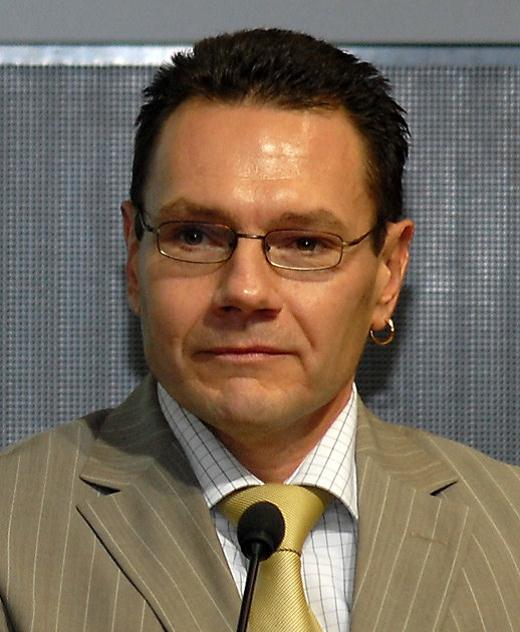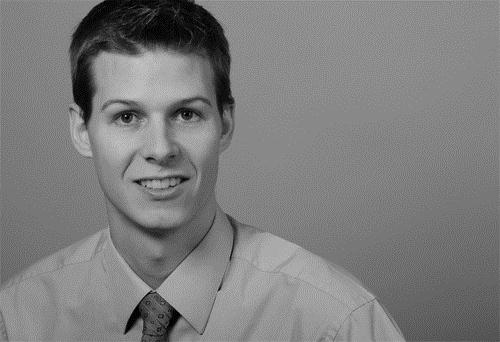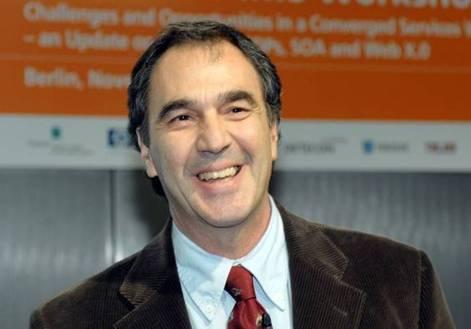ICIN 2012
Monday 8 October 09:00-12:30 – Tutorials
- Towards a Converged M2M Service Platform: Motivation, Standards and Applications
- Service Control Paradigms in Future Networks: Client-server, P2P and Network Intelligence
Thursday 11 October 09:00-17:00 – Collocated workshops
- MediaSync 2012 workshop
- The 2nd ULOOP Industrial Workshop
- Smart Home Standardisation Ecosystem workshop
Tutorials
Monday 8 October
Towards a Converged M2M Service Platform: Motivation, Standards and Applications
Prof. Dr. Thomas Magedanz and Dr. Sebastian Wahle, TU Berlin / Fraunhofer FOKUS, GermanyToday the concept of mobile broadband communication is gaining momentum and the related 3GPP specifications are forming the technology foundation for enabling the connectivity for a massive number of devices. This communication opportunity is augmented by the development of new Over-The-Top (OTT) applications either imported from fixed internet or especially tailored as mobile services. Apart from the user controlled smartphones, tablets and laptops which are gradually adopted by mobile users, new devices such as sensors and actuators are currently deployed enabling the extension towards efficient remote communication of other business branches such as eHealth, eGovernment, eEnergy, eTransport in addition to Smart Grid and Smart Cities systems.
Modern cities need a flexible M2M communication infrastructure based on convergent networks that lay the foundation for new applications and their flexible combination. This leads to new possibilities for the use of previously isolated applications and data that are now the basis for new business models. For example, environmental data can be combined with up-to-date values attained from within the building to ensure the more efficient and automatic control of heating and ventilation systems. A uniform M2M communication infrastructure can make those and many other applications possible in both the private and industrial sectors.
This half day tutorial will provide an overview of delivery platforms including the IP Multimedia Subsystem (IMS) especially from the perspective of the deployment of a massive number of Machine Type Communication devices. Additionally, the novel ETSI standardized M2M platform will be introduced and analyzed. Finally, the M2M challenges, which motivated the development of the Fraunhofer FOKUS / TU Berlin OpenMTC (www.open-mtc.org) platform, will be discussed.

Thomas Magedanz (PhD) is full professor in the electrical engineering and computer sciences faculty at the Technical University of Berlin, Germany, leading the chair for next generation networks. In addition, he is director of the “next generation network” division of the Fraunhofer Institute FOKUS, which also provides a national Next Generation Network testbed in Germany. Since more than 18 years he is working in the convergence field of fixed and mobile telecommunications, the internet and information technologies, which resulted in many industry driven R&D projects centred around Next Generation Service Delivery platforms.
In 2006, Prof Magedanz has been assigned as visiting professor at the electrical engineering faculty of the University of Cape Town and as adjunct professor at the electrical engineering faculty of the University of Pretoria. Since 2007 he is also adjunct professor for Next Generation Networks at the TSSG Institute in Waterford, Ireland.

Dr Sebastian Wahle joined the Next Generation Network Infrastructure department at Fraunhofer FOKUS in Berlin, Germany in 2005. Since then, he served as a project manager leading the research & development activities of several industry and publicly funded research projects. In 2009, he established the Evolving Infrastructure and Services group at Fraunhofer FOKUS. The group is active in a number of national and international research projects in the field of Future Internet and supports commercial Fraunhofer Next Generation Network (NGN) testbed deployments at customer premises worldwide.
Since 2011, Sebastian is responsible for the Machine-to-Machine (M2M) Business Development and heads the OpenMTC group at Fraunhofer FOKUS that is currently building a generic M2M platform enabling services across multiple vertical application domains.
Service Control Paradigms in Future Networks: Client-server, P2P and Network Intelligence
Roberto Minerva, Head of Innovative Architectures, Future Centre, Telecom ItaliaIn Future Networks services and applications will be a differentiation factor for Service Providers and Communication Service Providers. The ability to quickly and effectively create services that leverage the assets of the providers and that fulfill users’ expectations will be of paramount importance. Currently there are some major trends in the way networked services are provided: namely, client-server, network intelligence, and peer-to-peer paradigms. These paradigms will likely be prevalent also in Future Networks, even if some other paradigms (e.g. Publish, Subscribe, Tuple space and others) will acquire importance due to the integration and emergence of Wireless Sensor Networks and Adaptive Networks. This tutorial provides a view on how the leading paradigms can be used to create services and how they allow leverage of the networked assets of different providers. The client-server paradigm will lead to a cloud-based organization of the network and services, the network intelligence one will leverage future evolution in alignment with the current proposal of 4G focusing on services still strongly related to the infrastructure, eventually the peer-to-peer one seems to be the one more aligned with the original principles of the internet and could be exploited as a means to set the way towards a new and open Future Network in which several providers could openly compete in the market.

Roberto Minerva is the Head of Innovative Architectures within the Future Centre in the Strategy Department of Telecom Italia. His job is to create advanced scenarios derived from the application of emerging ICT technologies with innovative business models. Roberto is also a contract Professor at Turin Polytechnic teaching a course on mobile services. He has held many responsibilities within Telecom Italia Lab: Network Intelligence, Wireless Architecture and Business Services Area Manager.
Roberto has a Master’s Degree in Computer Science. Since 1987 he has been involved in the development of Service Architectures for Telecom (TINA, OSA/Parlay and SIP), in activities related to IMS, and in the definition of services for the Business market (context-awareness, ambient intelligence and automotive). Roberto is the author of several papers published in international conferences, books and magazines.
Workshops
Thursday 11 October
MediaSync 2012 workshop
Media synchronization has been a challenge in A/V transmission for quite some time. Over the years, many techniques to achieve intra- and inter-media synchronization in various network conditions have been developed. In many cases, synchronization between different streams of media is crucial for a satisfying perceived Quality of Experience (QoE). Currently, many new media synchronization issues arise. On the one hand, novel media technologies such as HTTP streaming protocols, media encoders and HDTV often require new synchronization techniques. On the other hand, new patterns in media consumption often introduce specific synchronization issues. For example, internet applications evolving around broadcast TV content may need synchronization between the application and the broadband stream. Synchronization between different TV receivers may be needed in Social TV (inter-destination media synchronization). In some interactive TV cases synchronization between handheld devices and the TV screen may be needed. Moreover novel 3D technologies for TV broadcasting and tele-presence (3D tele-immersion) may require the adoption of several of these synchronization techniques to achieve a satisfying user experience. This workshop addresses various synchronization issues and requests contributions from different perspectives.
Workshop Proceedings: download the accepted papers from the presentations at the workshop here.
Session1: Introduction & State-of-the-art
10:00-10:10
Welcome to the workshop
Workshop organizers: Pablo Cesar (CWI), Fernando Boronat (UPV), Hans Stokking (TNO)
10:10-10:30
Introduction to Media Synchronization, state-of-the-art (UPV, TNO, CWI)
10:30-10:50
Coffee Break
Session 2: Position papers
10:50-11:15
Uplink Transfer of Live Video Synchronized with Multiple Contextual Data
Ahmed Bouabdallah, Institut Mines-Telecom; Telecom Bretagne, Université européenne de Bretagne
11:15-11:40
Interactive Multi-source Media Synchronisation for HbbTV
Lourdes Beloqui Yuste, College of Engineering & Informatics, National University of Ireland
11:40-12:05
Keeping the User in Control: “Synchronization” vs “Being in-sync”
Ishan Vaishnavi, Huawei European Research Center
12:05-12:30
Audio Fingerprinting for Media Synchronisation and Duplicate Detection (FP7 LinkedTV)
Daniel Stein, Fraunhofer Institute for Intelligent Analysis and Information Systems
12:30-13:30
Lunch
Session 3: European projects and synchronization
13:30-13:55
Media Synchronization in Vconect (FP7 Vconect)
Tim Stevens, BT
13:55-14:20
Frame accurate media synchronization of heterogeneous media sources in an HBB context (FP7 HBB-Next)
Arjen Veenhuizen, TNO
14:20-14:45
Synchronization in hybrid multi-view entertainment distribution systems [FP7 DIOMEDES & FP7 ROMEO]
Erhan Ekmekcioglu, I-Lab Multimedia Communications Research, Centre for Vision, Speech and Signal Processing, University of Surrey
14:45-15:10
Media Synchronization in REVERIE (FP7 REVERIE)
Rufael Mekuria, CWI
15:10-15:40
Coffee Break
Session 4: Standardization activities and synchronization
15:40-16:05
Media Synchronization Standardization at W3C
Jack Jansen, CWI
16:05-16:30
IDMS standardization in IETF and ETSI
Hans Stokking, TNO
Session 5: Recap and (panel) discussion
16:30-17:30
Future Challenges in Media Sync
UPV, TNO, CWI
17:30
Drinks and Demos
The workshop is sponsored by the following projects:



The 2nd ULOOP Industrial Workshop
ULOOP is a FP7 project that brings a fresh approach to user-centricity by exploring user-provided networking aspects in a way that expands the reach of a multi-access backbone. ULOOP addresses the user as a key component of networking services in future Internet architectures. ULOOP’s main expected results are user-centric open-source software and a large-scale realistic demonstrator. The ULOOP consortium contains a total of 12 partners including three operators, two access vendors, a software house, four universities, as well as an R&D Laboratory. The project is jointly coordinated by Alcatel-Lucent Bell Labs France with Lusófona University (SITI, Informatics Systems and Technologies R&D Unit).
The Rise of User-centric Wireless Networks
The second ULOOP industrial workshop is intended to provide industry partners with an overview concerning technical innovation derived from the ULOOP project and also to raise awareness of the impact of user-centric wireless networks. Throughout one day, the agenda shall bring together a technological perspective on user-centric wireless innovation; standardization impact, as well as impact from a regulation and socio-economic perspective.
The workshop shall provide:
- An overview concerning the technical issues that ULOOP is developing
- A debate concerning the rise of user-centric wireless networks, their potential advantages, opportunities, and threats from an access perspective
- A platform for discussing different views with industry leaders
- The perspective of standardization experts concerning user-centric technology for wireless networks.
Target Audience
The ULOOP industrial workshop is directed to network operators, access and service providers, internet stakeholders, municipalities or living-labs with an interest in discussing trends and new ideas in wireless communities.
There is no attendance fee for the 2nd ULOOP Industrial Workshop but registration is required.
Agenda
09:00-09:15
Welcome to the workshop
Olivier Marcé, Alcatel-Lucent Bell Labs France
09:15-09:45
Keynote Speech
Peretz Feder, Alcatel-Lucent, WPA and HotSpot 2.0
09:45-10:45
ULOOP Overview
Rute Sofia, SITI, Universidade Lusófona
10:45-11:00
Coffee Break
11:00-13:00
Trust Management in ULOOP (including demo)
Invited speaker: Dr. Joerg Abendroth, NSN
This session provides an overview on how ULOOP perceives trust management
13:00-14:30
Lunch
14:30-16:00
Resource Management in ULOOP (including demo)
Invited speaker: representative from FLAVIA project
This session provides an overview on ULOOP resource management aspects
16:00-16:30
Coffee Break
16:30-18:00
Mobility Management in ULOOP (including demo)
Invited speaker: H Anthony Chan, Huawei
This session covers mobility aspects dealt with in ULOOP

Smart Home Standardisation Ecosystem workshop
How can the Smart Home Ecosystem Deliver a Compelling Customer Experience?Emerging services in the home environment present massive opportunities for operators and service providers. However, these opportunities will only materialize if an effective and fit-for-purpose ecosystem is available to support their development and deployment. Moreover, this smart home ecosystem must be the ultimate answer to a compelling customer experience!
This workshop brings together operators, standards organizations, industry fora and suppliers for an open and honest examination of the difficulties currently faced by operators and consumers in implementing home environment services, and an exploration of how to resolve these difficulties through cooperation between the various members of the ecosystem.
Keynote addresses from leading telcos will address the pain points they experience in the smart home domain. Incisive panel discussions will examine how standardization bodies can develop a fit-for-purpose ecosystem to support the telcos and will discuss the role of telcos and vendor companies in building sustainable business models in the Smart Home domain.
 Co-sponsored by:
Co-sponsored by: 
At T-Labs, Ernst-Reuter-Platz, Berlin
Directions to T-Labs can be downloaded here.
Agenda
09:45-10:00
Opening Remarks
Vinay Aggarwal, Telekom Innovation Laboratories (T-Labs)
10:00-11:30
Telco Keynotes
What are the pain points experienced by telcos in the smart home domain?
What support do telcos seek from standardization bodies in addressing these pain points?
Building a Smart Home ecosystem - The urgency for standardization
Carsten Steigleder, Deutsche Telekom
Smart home services and standards: the Telecom Italia experience
Luca Giacomello, Telecom Italia
Big changes start small – conserve resources by not printing every e-mail
Patricia Martigne, France Telecom
11:30-12:30
Smart Home Technologies and Solutions
DECT ULE Technology and Ecosystem
Jochen Kilian, DSP Group
NEC’s Smart Home Technologies and Solutions in real life
Andreas Fleck, NEC
12:30-13:30
Lunch
13:30-15:00
Panel: Addressing Telco pain points through standardization
Moderator: Lindsay Frost, NEC
Panelists
* Robin Mersh, CEO, Broadband Forum
* Luca Giacomello, Telecom Italia & Chairman, Home Gateway Initiative
* Hiroshi Ota, ITU-T
* Txema Ogara, HomePlug
* Andreas Kraft, OSGi Alliance
15:00-15:15
Coffee Break
15:15-16:45
Panel: Building sustainable business models in the Smart Home domain – the role of telcos and vendor companies
Moderator: Robin Mersh, CEO, Broadband Forum
Panelists
* Patricia Martigne, Orange
* Carsten Steigleder, Deutsche Telekom
* Jochen Kilian, DSP Group & DECT ULE Forum
* Torsten Witusch, Managing Director, Connected Living Initiative
16:45-17:00
Closing Remarks
Hans Werner Bitzer, Telekom Innovation Laboratories (T-Labs)
































